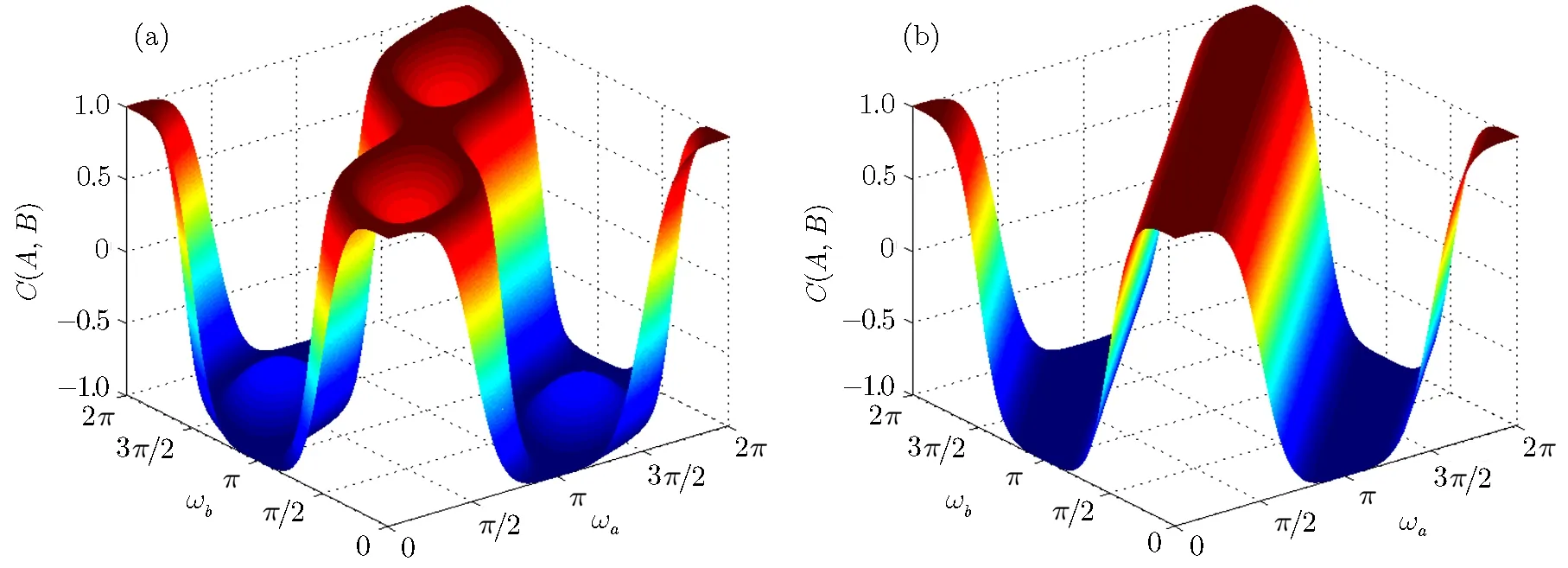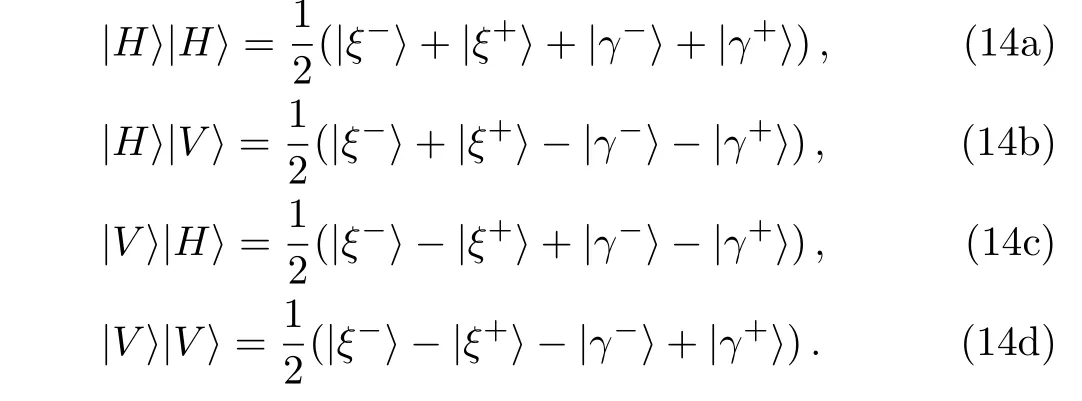Implementation Scheme of Two-Photon Post-Quantum Correlations∗
2018-06-15GuoZhuPan潘国柱WenJingChu储文静MingYang杨名QingYang杨青GangZhang张刚andZhuoLiangCao曹卓良
Guo-Zhu Pan(潘国柱)Wen-Jing Chu(储文静)Ming Yang(杨名)† Qing Yang(杨青) Gang Zhang(张刚)and Zhuo-Liang Cao(曹卓良)‡
1School of Physics and Material Science,Anhui University,Hefei 230601,China
2School of Electrical and Photoelectric Engineering,West Anhui university,Lu’an 237012,China
3School of Electronic and Information Engineering,Hefei Normal University,Hefei 230601,China
1 Introduction
Quantum systems can have correlations different from those of classical systems.Considering two separated observers,Alice and Bob,sharing a quantum state,each chooses one from a set of possible measurements and obtains some outcomes.In the quantum states with the property of being entangled,Alice and Bob can observe correlations,which cannot be explained by classical models defined in terms of local hidden variables.These nonlocal correlations can be detected by observing violations of the CHSH inequalities.[1−5]A key feature of nonlocal correlations is that it does not allow the two observers to send information to each other faster than light,i.e.,correlations from the measurements on quantum states are non-signaling.

2 Quantum Description of Pre-and Post-Selected Ensembles
Quantum measurement[33−34]plays an essential role in extracting information from a physical system of interest.To observe the post-quantum correlations in quantum systems,pre-and post-selected ensembles must be prepared.[25]That is to say,the generalized description of a quantum system in the time interval between two measurements must be introduced,[23−24]where the generalized state completely describes a quantum system when information about the system is available both from the past and from the future.For a given pre-and postselected ensemble,suppose the initial state is|ψi⟩and the final state is|ψf⟩,and thus the probability for an outcome|cn⟩of an ideal measurement on an observableCat intermediate time is given by ABL formula:[23−24]


3 Implementation of Two-Photon Supercorrelations in Optical System
In what follows,we describe in detail how to obtain supercorrelations in pre-and post-selected photon ensembles.Consider a two-photon system whose initial and final states are



For a given system,the CHSH value is defined asBCHSH=|C(A,B)−C(A,B′)+C(A′,B)+C(A′,B′)|,[1]whereAandA′are two-valued(±1)variables for the if rst system,andBandB′are similar variables for the second system.The functionC(A,B)=PAB(1,1)+PAB(−1,−1)−PAB(1,−1)−PAB(−1,1)represents the expected value ofAandBfor the two systems,andPAB(1,1)denotes the joint probability of obtainingA=1 andB=1 whenAandBare measured.
According to the ABL formula(1),the correlations of two observablesAandBmeasured by Alice and Bob are given by

wherex=cos2θ−cos4θ,andωaandωbare the measurement directions chosen by Alice and Bob,respectively.The CHSH valueBCHSHdepends on the value of the correlation functionsC(A,B),which are determined by three parametersx(the parameter of the initial and final states),ωa,andωb(the parameters of the intermediate measurements).As depicted in Fig.1,whenx=0,BCHSH=0,there is no correlation between Alice’s and Bob’s measurements;However,whenx>0,the CHSH inequality can be violated.For example whenx=0.25,ωa=3π/2,ωa′=π,ωb=9π/8,ωb′=7π/8,we can getC(A,B)=0.668,C(A,B′)=−0.668,C(A′,B)=0.997,C(A′,B′)=0.997,and thus the CHSH value of the system is 3.33.Furthermore,whenx→0,ωa=3π/2,ωa′=π,ωb→π+(approachingπfrom the right),ωb′→π−(approachingπfrom the left),C(A,B)→1,C(A,B′)→−1,C(A′,B)→1,C(A′,B′)→1,so we can obtain the maximal value of the CHSH inequalityBCHSH→4.From the plots in Fig.1 we can see that the final CHSH valuesBCHSHvary drastically with the parametersωa,ωbof the intermediate measurements,but only slightly with the parameterxof the initial and final states.Fortunately,the parametersωa,ωbof the intermediate measurements can be easily controlled via tuning the angles of the HWPs.

Fig.1 The correlations C(A,B)are plotted as functions of the parameters of the intermediate measurements ωa,ωb and the parameter x of the initial and final states.(a)x=0.05,(b)x=0.25.


which can be re-expressed in the rotated basis of Eq.(4)as

The second step is to realize the local measurements of the photonic states in the basis of Eq.(4)without absorbing the photons,which can be implemented by half-wave plates,cross-Kerr nonlinear interactions between signal photons(entangled photons here)and the probe light beams,and the detection of probe beam.After the entangled photons being distributed to Alice and Bob,they each will perform a quantum non-demolition measurement on the photon polarization via cross-Kerr nonlinearity.Here the half-wave plates(HWP)1,2,with their axes set atα=ωa,b/4 with respect to the horizontal direction,rotate the photon polarization as|H⟩↔|↑⟩,|V⟩↔|↓⟩.After the photons passing through the HWPs 1,2,respectively,the state of the two photons becomes


Fig.2 Schematic setup for realizing supercorrelations.HWP1 and HWP2 realize the basis transformation| ↑⟩(| ↓⟩)↔ |H⟩(|V⟩).HWP3 rotates the photon polarization as|H⟩↔ sinθ|H⟩+cosθ|V⟩,|V⟩↔ −cosθ|H⟩+sinθ|V⟩.The+ϑ represents the cross-Kerr nonlinear interaction between the signal photon and the probe coherent beam,where the signal photon will induce a phase shift+ϑ on the coherent beam|α1,2⟩pin the probe mode.|X⟩⟨X|represents an X quadrature homodyne measurement.PBSi(i=1,2,3,4,5)are polarizing beam splitters in{|H⟩,|V ⟩}basis,and PBS6

AfterXquadrature homodyne measurements being performed on the probe beams,the two-photon state will collapse into one of the following four basis states:|HH⟩,|HV⟩,|V H⟩,|V V⟩.Then we can move to the last step—post-selection.
To realize the supercorrelations,the post-selection measurement basis must be chosen as:

Under the above basis,the collapsed two-photon states can be re-expressed as:



In practical experiment,the entanglement source produced by SPDC is not always perfect,which usually generates an entangled state of the form[41−42]


4 Implementation of Two-Photon PR Correlations in Pre-and Post-Selected Ensembles
We proceed by considering two-photon ensembles with a maximally entangled initial and final state.



The set of post-selection measurement basis must be chosen as:

Under the above basis,the two-photon state can be written as:


⟩
,|γ−⟩→|V V⟩,|γ+⟩→|HV⟩.Thus the correct final state can be distinguished by the direct measurements.
5 Conclusion
In this paper,we designed an implementation scheme for simulating postquantum correlations by exploiting the fair-sampling loophole in Bell test of bipartite states,which is opened naturally in the“two-state vector formalism”of quantum mechanics without introducing auxiliary Hilbert space,and we can get the probability distributions not only violating CHSH inequality but also surpassing the Tsirelson’s bound.Under the “two-state vector formalism”,the fair-sampling loophole of Bell test is opened by the selection of the results after measurement,which is different from the currently existing simulation schemes for postquantum correlations where the fairsampling loophole is opened by pre-selecting the states to be measured.Our results verify that the selection of the results after measurement can open fair-sampling loophole too,which can be used to simulate postquantum correlations as well.In addition,our scheme diversifies the simulation tools for postquantum correlations.

[1]J.F.Clauser,M.A.Horne,A.shimony,and R.A.Holt,Phys.Rev.Lett.23(1969)880.
[2]M.A.Rowe,D.Kielpinski,V.Meyer,et al.,Nature(London)409(2001)791.
[3]W.J.Chu,X.L.Zong,M.Yang,et al.,Sci.Rep.6(2016)28351.
[4]M.Li,Y.F.Huang,and G.C.Guo,Commun.Theor.Phys.67(2017)267.
[5]A.Basit,H.Ali,F.Badshah,and G.Q.Ge,Commun.Theor.Phys.68(2017)29.
[6]B.S.Tsirelson,Math.Phys.4(1980)93.
[7]S.Popescu and D.Rohrlich,Found.Phys.24(1994)379.
[8]J.Barrett,N.Linden,S.Massar,et al.,Phys.Rev.A 71(2005)022101.
[9]T.Short,N.Gisin,and S.Popescu,Quantum Inf.Process.5(2006)131.
[10]W.van Dam,arXiv:quant-ph/0501159.
[11]N.J.Cerf,N.Gisin,S.Massar,and S.Popescu,Phys.Rev.Lett.94(2005)220403.
[12]H.Buhrman,M.Christandl,F.Unger,et al.,Proc.R.Soc.A 462(2006)1919.
[13]E.Pomarico,B.Sanguinetti,P.Sekatski,et al.,New J.Phys.13(2011)063031.
[14]I.Gerhardt,Q.Liu,A.Lamas-Linares,et al.,Phys.Rev.Lett.107(2011)170404.
[15]J.Romero,D.Giovannini,D.S.Tasca,et al.,New J.Phys.15(2013)083047.
[16]N.Gisin,Phys.Lett.A 210(1996)151.
[17]N.Gisin and B.Gisin,Phys.Lett.A 260(1996)323.
[18]D.S.Tasca,S.P.Walborn,F.Toscano,and P.H.Souto Ribeiro,Phys.Rev.A 80(2009)030101.
[19]D.W.Berry,H.Jeong,M.Stobi´nska,and T.C.Ralph,Phys.Rev.A 81(2010)012109.
[20]M.Ringbauer,A.Fedrizzi,D.W.Berry,and A.G.White,Sci.Rep.4(2014)6955.
[21]A.Cabello,Phys.Rev.Lett.88(2002)060403.
[22]Y.A.Chen,T.Yang,A.N.Zhang,et al.,Phys.Rev.Lett.97(2006)170408.
[23]Y.Aharonov,P.G.Bergman,and J.L.Lebowitz,Phys.Rev.134(1964)B1410.
[24]Y.Aharonov and L.Vaidman,J.Phys.A 24(1991)2315.
[25]S.Marcovitch,B.Reznik,and L.Vaidman,Phys.Rev.A 75(2007)022102.
[26]Y.Q.He,D.Ding,F.L.Yan,and T.Gao,Opt.Express 23(2015)21671.
[27]L.Zhou,L.Q.Chen,W.Zhong,and Y.B.Sheng,Laser Phys.Lett.15(2018)015201.
[28]Y.B.Sheng and L.Zhou,Sci.Bull.62(2017)1025.
[29]S.S.Chen,L.Zhou,and Y.B.Sheng,Laser Phys.Lett.14(2017)025203.
[30]L.Dong,J.X.Wang,Q.Y.Li,et al.,Phys.Rev.A 93(2016)012308.
[31]L.Dong,Y.F.Lin,Q.Y.Li,et al.,Ann.Phys.371(2016)287.
[32]D.Bouwmeester,J.Pan,K.Mattle,et al.,Nature(London)390(1997)575.
[33]A.Peres,Quantum Theory:Concepts and Methods,Kluwer,Dordrecht(1993).
[34]Y.Aharonov and D.Rohrlich,Quantum Paradoxes:Quantum Theory for the Perplexed,Wiley,Weinheim(2005).
[35]T.Tashima,T.Wakatsuki,S.K.Ozdemir,et al.,Phys.Rev.Lett.102(2009)130502.
[36]K.J.Resch,J.S.Lundeen,and A.M.Steinberg,Phys.Lett.A 324(2004)125.
[37]S.D.Barrett,P.Kok,K.Nemoto,et al.,Phys.Rev.A 71(2005)060302.
[38]W.J.Munro,K.Nemoto,and T.P.Spiller,New J.Phys.7(2005)137.
[39]L.H.Zhang,Q.Yang,M.Yang,et al.,Phys.Rev.A 88(2013)062342.
[40]T.B.Pittman,M.J.Fitch,B.C.Jacobs,and J.D.Franson,Phys.Rev.A 68(2003)032316.
[41]T.Yamamoto,M.Koashi,and N.Imoto,Phys.Rev.A 64(2001)012304.
[42]Y.B.Sheng,L.Zhou,S.M.Zhao,and B.Y.Zheng,Phys.Rev.A 85(2012)012307.
[43]C.H.Bennett and D.P.Divincenzo,Nature(London)404(2000)247.
[44]P.G.Kwiat,A.M.Steinberg,and R.Y.Chiao,Phys.Rev.A 45(1992)7729.
[45]X.H.Bao,T.Y.Chen,Q.Zhang,et al.,Phys.Rev.Lett.98(2007)170502.
[46]L.Zhou and Y.B.Sheng,Phys.Rev.A 92(2015)042314.
[47]H.Schmidt and A.Imamoglu,Opt.Lett.21(1996)1936.
[48]B.He,A.V.Sharypov,J.Sheng,et al.,Phys.Rev.Lett.112(2014)133606.
[49]N.Matsuda,R.Shimizu,Y.Mitsumori,et al.,Nature Photonics 3(2009)95.
[50]J.H.Shapiro,Phys.Rev.A 73(2006)062305.
猜你喜欢
杂志排行
Communications in Theoretical Physics的其它文章
- Thermodynamic Nonequilibrium Features in Binary Diffusion∗
- Ordinary Mode Instability in a Cairns Distributed Electron Plasma
- Thermal Conductivity of Complex Plasmas Using Novel Evan-Gillan Approach
- Spontaneous Emission Originating from Atomic BEC Interacting with a Single-Mode Quantized Field
- Molecular Dynamics Simulations of the Elastic Anisotropy of Pd at Extreme Conditions∗
- In fluences of Crystal-Field and Interlayer Coupling Interactions on Dynamic Phase Diagrams of a Mixed-Spin(3/2,2)Bilayer System∗
